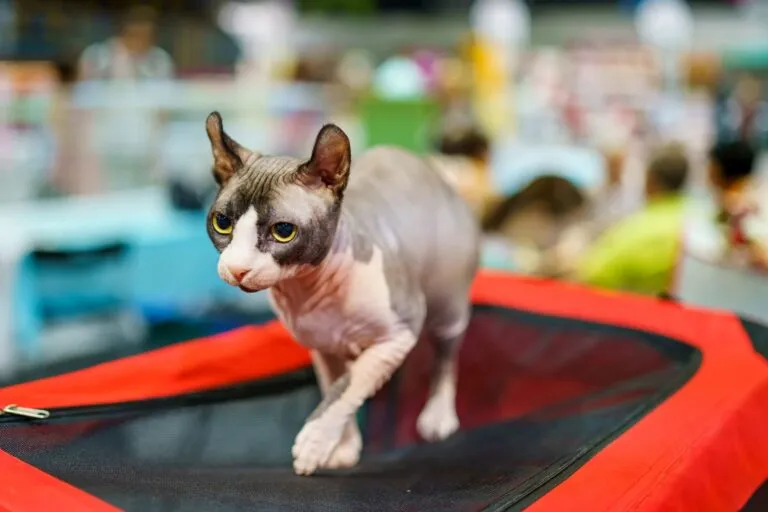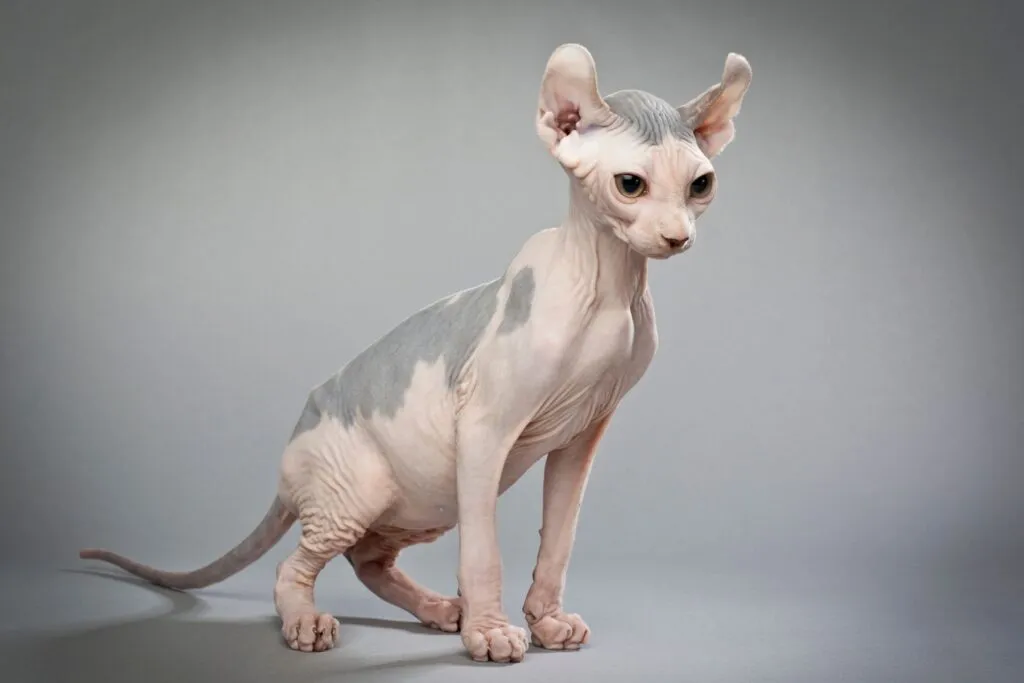Maine Coon
The Maine Coon has become one of the most popular cat breeds in the world. This is probably due to its majestic appearance, robust nature and great character.
Hairless, wrinkly, and with curled ears: the playful and cuddly Elf Cat looks quite different from your average feline friend. This rare breed is one of the hairless variety and only emerged at the start of the 21st century in the USA – to some, it is considered a product of controversial breeding practices. In this article, we'll share everything there is to know about this unique breed.

© Vadim / stock.adobe.com
An elf cat is intended solely for indoor living and is too delicate for outdoor roaming.
The Elf Cat has only been around since 2004, created in the USA by Karen Nelson and Kristen Leedom. The breeders crossed American Curl and Sphynx cats to forge a new cat breed altogether.
The goal was to blend the people-oriented nature of the Sphynx with the curled ears of the American Curl. Their experiment was successful, giving rise to the Elf Cat that we know today.
This nascent hybrid breed is not yet officially recognised as a separate breed. At cat shows held by the International Cat Association (TICA), it is listed as a variant of the Sphynx. Elf Cats and breeders specialising in them are still rather rare – especially in Europe where the demand for these pets is limited.
There is some debate over whether breeding a cat without fur is inhumane. Officially, all hairless breeds like the Elf Cat are considered cases of inhumane breeding. The hairless body is more susceptible to skin diseases and the effects of the weather, causing these cats to often struggle with sunburn and eczema, and they easily get cold.
However, breeds like the Elf Cat are also bred without whiskers, which are important for cats’ spatial awareness. Every cat lover knows how crucial these fine hairs on the cheeks, above the eyes, and on the front legs are for a cat’s orientation.
Without whiskers, cats have limited sensory perception, especially in the dark. They lack an essential sense needed for normal behaviours such as stalking, hunting, or jumping.
Typically, Elf Cats have no fur at all, though there are rare occasions where a fine, smooth down can be found. This places them among the classic hairless breeds, akin to the Kohona.
All colours and patterns are permitted. The skin often creates folds, particularly around the shoulders, legs, and head.
The Elf-like ears are set atop a delicate, dog-like head with an elongated face. The distinct, whisker-free cheeks stand out, accentuated by the folding skin around the ears and eyes. The often bright, green-grey eyes appear especially large and striking due to the lack of fur.
Magical Pointy Ears? The unique ear shape of the Elf Cat inspired its name, reminiscent of elves found in legends and fantasy films. It’s purely fanciful to attribute any magical abilities to Elf Cats.
Elf Cats vary in weight, typically ranging from 4.5 to 7kg with a withers height of approximately 22 to 25cm.
Despite their delicate and sometimes fragile appearance, they are quite strong: Elf Cats have well-defined muscles, which are particularly noticeable due to their hairless look. Their athletic physique is accentuated by a long, tapered tail.
The athletic structure and the shape of its head are very reminiscent of the Sphynx, while the distinctively curled pointy ears hint at a kinship with the American Curl.
Social Elf Cats love to be the centre of attention. They follow their humans everywhere, investigate whatever their people touch, and seek to be involved in all human activities.
They often “talk” quite a bit and engage in extensive communication with their humans. In the absence of people, they’ll gladly keep company with other household pets such as dogs or rabbits, while remaining friendly and gentle.
Elf Cats have a fondness for play and are known for being particularly curious. These extroverted cats enjoy the hustle and bustle of life with all eyes on them.
Blessed with a heap of intelligence, the Elf Cat requires constant engagement and new challenges. If left to their own devices, these agile creatures will find their own adventures, with nothing quite out of reach.
After a bout of exploration, the Elf Cat longs for loving attention. They crave an abundance of cuddles and regularly seek out affection from their humans.
Fluffy it’s Not What does it feel like to stroke a hairless cat? It’s notably unusual but not unpleasant, as your fingers glide over the sleek, soft skin.
The Elf Cat should always be kept as an indoor cat. Lacking protective fur, it can’t shield itself from cold, sun, or wet conditions.
These carefree moggies are quick to get chilly, sunburned, or catch a cold, hence it’s best for Elf Cats to reside indoors. However, there’s no harm in allowing them supervised outdoor access in a secure garden. Cat clothing can also provide some protection against harsh weather.
The Elf Cat loves to climb, which keeps it physically fit. Although outdoor access is not an option, ensure it has plenty of scratching posts and climbing opportunities inside the home or flat.
Consider wall-mounted climbing structures to ensure your elfin friend leads a content life. Elf Cats are curious and crave variety, so rearrange their climbing opportunities now and then to offer new stimuli.
The cat wouldn’t object to a variety of creative toys. Any form of fun and play is welcome. Spend ample time interacting with your Elf Cat, and it is likely to leave your furnishings in peace.
Cats are known to enjoy having their entourage, but the Elf Cat craves company on a whole other level. These social creatures yearn for any form of companionship. Being alone is not in their playbook.
Extended periods of solitude can distress them and damage their trust in their humans. If you’re regularly out and about, it’s essential to find your Elf Cat a companion – ideally another cat. You might also try pairing it with other domestic animals such as dogs or friendly rabbits.
Elf Cats require more care than their furred counterparts. Their skin needs plenty of attention. It produces more sebum, which can leave the cat feeling sticky and dirty.
To combat this, Elf Cats need regular baths. While wet wipes can help in between, it’s best if the cat is accustomed to washing from kittenhood.
The skin of many in this breed is prone to rashes and dryness. Consult your vet on how best to take care of the Elf Cat’s sensitive skin.
How Long Do Elf Cats Live? Elf Cats can live for approximately 14 years.
Ensure that your Elf Cat isn’t exposed to excessive sun. Their skin is highly sensitive and can burn quickly due to their nakedness.
Always provide the cat with a shady spot, and be vigilant to prevent regular skin irritation. Skin cancer, triggered by high UV radiation, is a common concern for cats of this breed.
Fur offers warmth, and since Elf Cats lack it, they depend on a cosy environment to avoid hypothermia and frostbite.
You can combat the prolific sebum production with a light diet, feeding your Elf Cat lean meals. Ensure that the cat’s food is high in protein but low in fat.
Discuss the appropriate diet for your Elf Cat with your vet. In specialist pet shops, you’ll find suitable products.
 © rusugrig / stock.adobe.com
© rusugrig / stock.adobe.com
Although a new breed, Elf Cats can be bought from breeders like other breeds. However, you may need to search longer and travel further to find the right breeder. These pets don’t come cheap: prices are around €2,000.
Consider the following when buying:
The Elf Cat is undoubtedly extraordinary, and its high-maintenance nature and breeding are not without controversy. Its appearance is rather special and has to be appealing to prospective owners. Tastes may vary, but one thing is certain: Elf Cats have a magical personality and can be an absolute delight.
| Unique Qualities: | The Elf Cat is a relatively young and extraordinary cat breed that is considered a product of inhumane breeding due to the absence of fur and whiskers. |
| Character: | Human-oriented, social, intelligent and active |
| Size: | 22-25cm in height |
| Weight: | Approx. 4.5-7kg |
| Eye Colour: | Green-grey |
| Colours: | All colours and patterns allowed |
| Fur: | None |
| Coat Care: | Regular baths and care necessary |
| Lifespan: | About 14 years |
| Typical Diseases: | Prone to skin conditions |
| Price: | Starting at approx. €2,000 |
| Origin: | USA |
Here are some purchase proposals curated by the zooplus editorial team
The products featured have been carefully selected by our editorial staff and are available at the zooplus online pet shop. The selection does not constitute advertising for the mentioned brands.
The Maine Coon has become one of the most popular cat breeds in the world. This is probably due to its majestic appearance, robust nature and great character.
Large eyes and attentively upright ears instantly tell you a great deal about this charming breed of cat: Abyssinians are inquisitive and affectionate towards people.
With its long, dense fur, rounded ears, and intense stare, the Pallas Cat, or Manul, looks rather fluffy, yet somewhat dangerous. However, don't be fooled by its appearance—this is no petting zoo resident. The Manul is a wild animal and considered untameable.